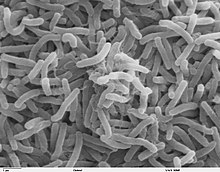Aerolíneas Argentinas Flight 386
| Occurrence | |
|---|---|
| Date | 14 February 1992 |
| Summary | Mass foodborne illness outbreak by cholera from airline meal |
| Site | In flight from Lima, Perú to Los Angeles, United States |
| Aircraft | |
| Aircraft type | Boeing 747-200B |
| Operator | Aerolíneas Argentinas |
| Flight origin | Ministro Pistarini International Airport, Buenos Aires, Argentina |
| Last stopover | Jorge Chávez International Airport, Lima, Perú |
| Destination | Los Angeles International Airport, Los Angeles, United States |
| Passengers | 336 |
| Crew | 20 |
| Fatalities | 1 |
| Injuries | 75 |
| Survivors | 355 |
On 14 February 1992, food contaminated with cholera was distributed to the passengers on Aerolíneas Argentinas Flight 386. One of the passengers died from the illness.
Description
[edit]On 14 February 1992, an Aerolineas Argentinas Boeing 747-287B, arrived in Los Angeles, California, United States, inbound from Ministro Pistarini International Airport, Buenos Aires, Argentina, via a scheduled stopover at Jorge Chávez International Airport, Lima, Perú.[1][2][3] There were 336 passengers and 20 crew members on board the Lima–Los Angeles leg of the flight.[4] Out of the 336 passengers, the United States was the final destination for 297 of them.[1] Two passengers selected Canada as their final destination, while 37 selected Japan.[1][3]

Contaminated shrimp entered the aircraft in Lima, a year after a cholera outbreak began in Peru.[2][3][4] Five passengers showed signs of the illness immediately after landing at Los Angeles International Airport.[2] Several days later that number rose to 76.[5] One of them, a man in his early seventies, died from the illness.[1][3][6] The cholera on the contaminated food did not spread to other areas within the United States.[1]
Even though the Peruvian caterer that provided the food to Aerolíneas Argentinas in Lima also provided service to other companies the same day and no signs of the illness were reported, the Argentine flag carrier blamed it for entering the contaminated food into the aircraft.[7] This led to a controversy that eventually ended with the airline banned from operating into Peruvian territory.[2]
Investigation and subsequent developments
[edit]An investigation by the Food and Drug Administration highlighted the problem patchwork of regulations for food safety.[8]
The International Civil Aviation Organization (ICAO) stated that the responsibility for the safety of the operator organization is not changed by subcontracting of catering or other services to third parties.[9]
In 1995, the World Health Organization in consultation with the ICAO and the International Maritime Organization developed explicit agreements on the management of transmission risks for cholera and other infectious diseases by air and sea.[10][11][12][13][14] In 1998 this led to improvements in aircraft disinfection procedures.[15]
The ICAO now takes the advice of the International Travel Catering Association.[16]
See also
[edit]- Japan Air Lines food poisoning incident
- Aerolíneas Argentinas accidents and incidents
- Foodborne illness
References
[edit]- ^ a b c d e Mydans, Seth (21 February 1992). "Cholera Kills One and Fells Many on Flight". The New York Times. Archived from the original on 4 July 2014.
- ^ a b c d Nash, Nathaniel C. (10 March 1992). "Latin Nations Feud Over Cholera Outbreak". The New York Times. Archived from the original on 4 July 2014.
- ^ a b c d Malnic, Eric (21 February 1992). "25 on Flight to LAX Show Signs of Cholera". Los Angeles Times. Archived from the original on 5 November 2012. Retrieved 27 July 2012.
- ^ a b Centers for Disease Control (CDC) (28 February 1992). "Cholera Associated with an International Airline Flight, 1992". Morbidity and Mortality Weekly Report. 41 (8). Centers for Disease Control and Prevention: 134–135. ISSN 0149-2195. PMID 1738360. Retrieved 16 February 2011.
- ^ Marian Segal. "Contaminated Food Causes Flight Fatality". BNET. Retrieved 11 January 2012.[dead link]
- ^ Comas, José (22 February 1992). "Un locutor de radio muere de cólera por la comida en Aerolíneas Argentinas" [A radio broadcaster dies from cholera in food on an Aerolíneas Argentinas flight] (in Spanish). El País. Archived from the original on 19 October 2012. Retrieved 27 July 2012.
- ^ "Cholera Cases on Jet Up to 65". The New York Times. 23 February 1992. Archived from the original on 9 March 2014. Retrieved 28 July 2012.
- ^ "When you eat on airlines or ships from foreign countries: dine at your own risk - food safety regulations are not standard", Nutrition Health Review, 22 June 1993 (also archived here)
- ^ "The ICAO Safety Management Manual" (PDF). International Civil Aviation Organization. para 2.1. Archived from the original (PDF) on 13 June 2007.
- ^ Plotkin, Bruce Jay; Kimball, Ann Marie (1997). "Designing an International Policy and Legal Framework for the Control of Emerging Infectious Diseases: First Steps (January – March 1997)" (PDF). Emerging Infectious Diseases. 3 (1): 1–9. doi:10.3201/eid0301.970101. PMC 2627592. PMID 9126439. Archived (PDF) from the original on 13 April 2013.
- ^ Fox J. (1996). "Convention on international civil aviation.". The regulation of international commercial aviation: the international structure. Dobbs Ferry, New York: Oceana Publications. Booklet 2.
- ^ International Civil Aviation Organization. "Facilitation": annex 9 to The Convention on international civil aviation. Montreal: International Civil Aviation Organization, 1990.
- ^ "ICAO meeting seeks ways to facilitate international air travel". ICAO Journal. 50: 23–4. May 1995.
- ^ "Medical Resolutions". ICAO. A35-12.
- ^ Medical Manual (PDF) (1st ed.). International Air Transport Association. June 2004. ISBN 92-9195-242-7. Archived from the original (PDF) on 23 April 2007. Retrieved 23 August 2016.
- ^ Jones, Peter (2004). Flight Catering. Routledge. ISBN 0-7506-6216-6. Archived from the original on 20 November 2007. Retrieved 29 October 2007.[page needed]
External links
[edit]
